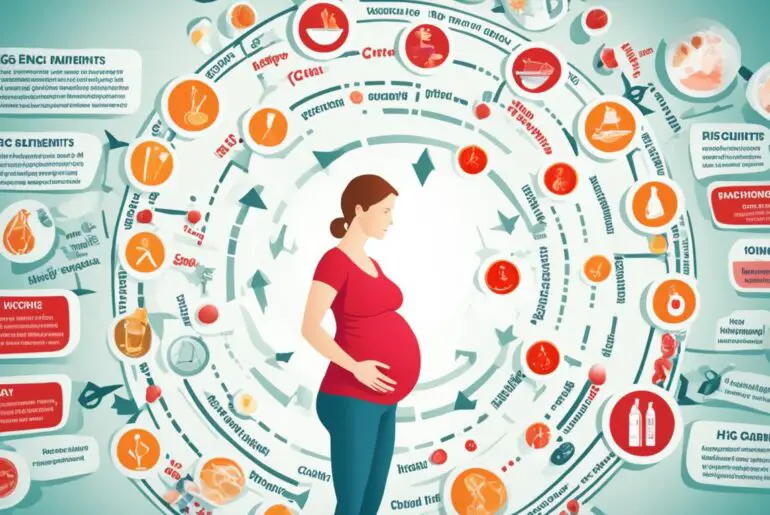Did you know that as high as 26% of all pregnancies end in pregnancy loss?
Researchers have found an association between low levels of the hormone human chorionic gonadotropin (hCG) and pregnancy loss or miscarriage. In this article, we will explore the research-based connections between low hCG levels and pregnancy loss, helping you better understand the impact of hCG on pregnancy outcomes.
Key Takeaways:
- Low levels of hCG have been associated with pregnancy loss or miscarriage.
- Multiple factors, including chromosomal abnormalities, can contribute to miscarriage.
- hCG is known as “the pregnancy hormone” and is produced by cells in the placenta to support the growth of the fertilized egg.
- Measuring hCG levels through blood tests and ultrasounds can provide insights into pregnancy development.
- Factors such as paternal age, environmental exposure, and lifestyle choices can influence pregnancy outcome.
Understanding Miscarriage and Potential Causes
As high as 26% of all pregnancies end in pregnancy loss, with multiple potential causes such as chromosomal abnormalities. Miscarriage, also known as pregnancy loss, refers to the spontaneous termination of a pregnancy before the 20th week. It is important to note that sometimes miscarriages occur without the person even knowing they were pregnant.
Chromosomal abnormalities are one of the most common causes of early pregnancy loss. These abnormalities occur when there are errors in the number or structure of chromosomes in the developing embryo. When the embryo has too many or too few chromosomes, it can prevent the pregnancy from progressing and result in a miscarriage.
While chromosomal abnormalities are a leading cause of miscarriage, there are other potential causes as well. These can include hormonal imbalances, uterine abnormalities, maternal age, chronic illnesses, infections, and lifestyle factors such as smoking and substance abuse.
It is important to note that the cause of a miscarriage is not always identified. Some miscarriages occur without a known reason, which can be emotionally challenging for individuals and couples experiencing pregnancy loss. However, medical professionals may conduct tests to help determine the cause when necessary.
Understanding the potential causes of miscarriage can provide individuals with knowledge and support during a difficult time. It is essential for anyone who has experienced a pregnancy loss to consult with their healthcare provider for guidance, emotional support, and personalized care.
Insightful Quote
“Miscarriage is a devastating experience for anyone who has gone through it. Knowing that the most common cause is chromosomal abnormalities can help individuals and couples process their grief and seek the necessary support.”
An image illustrating the potential causes of miscarriage, including chromosomal abnormalities.
The Role of hCG in Pregnancy

Doctors often refer to hCG as “the pregnancy hormone” because it is produced by cells in the placenta to support the growth of the fertilized egg.
During early pregnancy, hCG levels start to increase about 48 hours after implantation, and they typically double every 48 hours until around 8-11 weeks of pregnancy. This hormone plays a crucial role in maintaining the pregnancy and supporting the developing fetus.
The placenta, a vital organ that forms after implantation, produces hCG. Its primary function is to nourish and protect the developing embryo, providing essential nutrients and oxygen. In addition, hCG promotes the production of other hormones that are necessary for maintaining pregnancy, such as progesterone.
The levels of hCG in the body can be measured through a blood test or urine test. These tests are commonly used to confirm pregnancy and track its progression. A significant increase in hCG levels is often an indicator of a healthy pregnancy.
Quote: hCG is a critical hormone in pregnancy, as it helps to establish and maintain the pregnancy by supporting the growth and development of the fetus. It serves as an important marker for tracking the progress of pregnancy and assessing its viability.
Understanding the role of hCG in pregnancy is essential for healthcare providers in monitoring the health of pregnant individuals and identifying any potential issues. By tracking hCG levels, doctors can assess the development of the pregnancy and detect any abnormalities or complications.
Next, let’s delve into how hCG levels can be utilized to assess pregnancy development and predict potential issues.
Using hCG Levels to Assess Pregnancy Development
During pregnancy, hCG levels in the blood can provide valuable insights into the development of the pregnancy and potential issues. Doctors often use hCG blood tests in combination with ultrasound examinations to monitor fetal development and ensure the health of the mother and baby.
Ultrasound scans help visualize the progress of pregnancy by tracking the presence of gestational sacs, yolk sacs, and fetal heart motion. These fetal development markers are essential indicators of a healthy pregnancy.
Low levels of hCG may raise concerns and indicate potential problems, but they are not the direct cause of pregnancy loss. Instead, they serve as a signal for further investigation and medical attention to ensure the well-being of both mother and baby.
Using hCG Levels for Pregnancy Monitoring and Potential Issues
By analyzing hCG levels over time, healthcare professionals can assess how pregnancy is progressing and monitor the growth and development of the fetus. A series of hCG blood tests can reveal important information, such as:
- The presence of a gestational sac, which is the first visible sign of pregnancy.
- The appearance of a yolk sac, which provides vital nourishment to the fetus during early development.
- The presence of fetal heart motion, indicating a healthy heartbeat and proper development.
Ultrasound scans provide detailed images that allow doctors to detect these markers and assess the overall health of the pregnancy. This information helps healthcare providers make informed decisions regarding the next steps in prenatal care.
Interpreting hCG Levels and Pregnancy Development
It’s essential to understand that hCG levels can vary widely among individuals and aren’t the only factor in determining the outcome of a pregnancy. The rate at which hCG levels increase over time is equally significant.
While low hCG levels may cause concern, they do not confirm an inevitable miscarriage. Many factors contribute to pregnancy loss, and healthcare professionals consider hCG levels in conjunction with other indicators.
Below is a table summarizing the relationship between hCG levels and specific stages of pregnancy development:
| Pregnancy Stage | Associated hCG Levels |
|---|---|
| Gestational Sac Visible | 1,000-2,000 mIU/mL |
| Yolk Sac Present | 5,000-6,000 mIU/mL |
| Fetal Heartbeat Detected | 10,000-20,000 mIU/mL |
It’s important to remember that these ranges are approximate and may vary among individuals. Consult with a healthcare professional for personalized guidance and interpretation of hCG levels based on your specific circumstances.
Measuring hCG Levels for Pregnancy Viability Prediction

When it comes to predicting the viability of a pregnancy, healthcare professionals rely on measuring hCG levels over time. Repeatedly monitoring hCG levels during a 48-hour period can provide valuable insights into the progression and potential outcomes of early pregnancies.
Unlike initial hCG levels, which can vary widely among individuals, healthcare providers are more interested in how hCG levels increase over time. This upward trend in hCG levels is indicative of a healthy and developing pregnancy.
While many might be tempted to administer artificial hCG hormones in an attempt to boost hCG levels and prevent pregnancy loss, this approach has not been proven effective. In fact, medical professionals caution against the use of artificial hCG hormones as a preventative measure for pregnancy loss.
Instead, the focus lies on observing and understanding the natural progression of hCG levels, often supplemented by additional diagnostic methods such as ultrasound examinations. Ultrasounds provide visual confirmation of gestational sacs, yolk sacs, and fetal heart motion, offering further insights into the development of the pregnancy.
Using the hCG Blood Test and Ultrasound for Pregnancy Viability Assessment
The hCG blood test, combined with ultrasound examinations, offers a comprehensive approach to pregnancy viability prediction. The hCG blood test measures the levels of the hormone in the bloodstream, while ultrasound examinations provide visual confirmation of fetal development.
During the early stages of pregnancy, hCG levels typically rise rapidly. A slower increase or a decline in hCG levels can indicate a potential problem with the pregnancy. Healthcare providers will assess not only the absolute hCG levels but also the rate at which they increase to make accurate predictions about pregnancy viability.
It is important to note that while hCG levels can provide insights into the viability of a pregnancy, they do not directly cause pregnancy loss. Many factors contribute to pregnancy loss, and hCG levels are just one piece of the puzzle.
“The hCG blood test and ultrasound examinations allow us to assess pregnancy viability and monitor the development of the fetus. By analyzing the trends in hCG levels and observing fetal growth through ultrasound, we can gain valuable insights into the health of the pregnancy.”
| hCG Level | Pregnancy Outcome |
|---|---|
| High and increasing | Likely healthy pregnancy |
| Low and increasing | Potential risk, close monitoring required |
| Slow increase or decline | Potential problem, further investigation necessary |
Factors Influencing hCG Levels and Pregnancy Outcome
When assessing hCG levels and pregnancy outcome, two factors are taken into consideration: the initial hCG level and the rate at which it increases over time. These factors can provide valuable insights into the progression of the pregnancy and any potential complications that may arise.
Low hCG levels can be indicative of certain conditions, such as ectopic pregnancy or intrauterine pregnancy. However, it is important to note that low hCG levels in themselves do not cause pregnancy loss. Instead, they serve as an indication of the pregnancy’s development and can help healthcare providers monitor the progress.
The risk of pregnancy loss is highest during the first trimester, which spans from conception to the 12th week of pregnancy. It is during this crucial period that the body undergoes significant changes and the fertilized egg implants into the uterus. Monitoring hCG levels during this time can help identify any potential issues and guide appropriate medical interventions if needed.
Ectopic Pregnancy
Ectopic pregnancy is a condition where the fertilized egg implants outside of the uterus, most commonly in the fallopian tube. This is a life-threatening situation that requires immediate medical attention. Low hCG levels and slower rate of increase can be indicative of ectopic pregnancy, along with symptoms such as abdominal pain and vaginal bleeding.
Intrauterine Pregnancy
In contrast to ectopic pregnancy, intrauterine pregnancy occurs when the fertilized egg implants within the uterus, as it should. Normal hCG levels and a steady rate of increase are typically observed in cases of intrauterine pregnancy. Monitoring these levels can provide reassurance and support the identification of a healthy pregnancy progression.
Understanding the factors that influence hCG levels and their significance in assessing pregnancy outcome is crucial for healthcare providers and individuals experiencing pregnancy. By monitoring hCG levels, healthcare providers can detect potential issues early on and provide appropriate care to ensure the best possible outcome.
| Ectopic Pregnancy | Intrauterine Pregnancy |
|---|---|
| Low hCG levels | Normal hCG levels |
| Slower rate of increase | Steady rate of increase |
| Associated with symptoms such as abdominal pain and vaginal bleeding | Typically asymptomatic |
| Requires immediate medical attention | Normal course of pregnancy |
Other Factors Affecting Pregnancy Loss

When assessing the likelihood of pregnancy loss, it is important to consider various factors beyond hCG levels. These factors include advanced paternal age, occupational and environmental exposure to chemicals, alcohol consumption, and smoking. Understanding the impact of these factors can help healthcare professionals provide a comprehensive assessment of pregnancy outcomes.
The Influence of Paternal Age
Advanced paternal age has been associated with an increased risk of pregnancy loss. Research suggests that the quality of sperm may decline as men age, potentially leading to chromosomal abnormalities or other genetic defects that contribute to miscarriage. While the effect of paternal age on pregnancy loss is less pronounced than maternal age, it is a factor that should be taken into consideration.
Occupational and Environmental Exposure
Exposure to certain chemicals and toxins in the workplace or environment can have detrimental effects on pregnancy. Occupational hazards such as radiation, lead, pesticides, and solvents have been linked to an increased risk of pregnancy loss. Additionally, exposure to environmental pollutants and air pollution can also negatively impact fetal development and increase the likelihood of miscarriage.
Lifestyle Factors: Alcohol Consumption and Smoking
Unhealthy lifestyle habits such as alcohol consumption and smoking have been found to contribute to an elevated risk of pregnancy loss. Heavy alcohol consumption during pregnancy can result in fetal alcohol spectrum disorders and increase the chances of miscarriage. Similarly, smoking tobacco during pregnancy has been strongly associated with adverse pregnancy outcomes, including an increased risk of miscarriage.
“The potential impact of paternal age, occupational and environmental exposure, and lifestyle factors on pregnancy loss should not be overlooked. These factors can influence the overall health of a pregnancy and should be considered alongside hCG levels in determining the likelihood of pregnancy loss.”
To further illustrate the risks associated with these factors, the table below provides a comparison of their impact on pregnancy loss:
| Factor | Impact on Pregnancy Loss |
|---|---|
| Paternal Age | Increased risk, albeit less pronounced than maternal age |
| Occupational and Environmental Exposure | Elevated risk due to exposure to chemicals and toxins |
| Alcohol Consumption | Higher risk, particularly with heavy or frequent consumption |
| Smoking | Significantly increased risk, especially with regular tobacco use |
These factors should be carefully considered in conjunction with hCG levels to provide a comprehensive evaluation of pregnancy outcomes and guide appropriate interventions and support.
Bisphenol A (BPA) and Miscarriage Risk

Bisphenol A (BPA), an endocrine-disrupting chemical, has been associated with an increased risk of miscarriage. Studies conducted on animals have shown that exposure to BPA during pregnancy can have detrimental effects on fetal growth and development, leading to reproductive abnormalities.
While more research is needed to fully understand the impact of BPA on human pregnancies, it is advisable to take steps to reduce exposure to this potentially harmful chemical. Limiting the use of products that contain BPA, such as plastic bottles and food containers, can be an effective precautionary measure to safeguard reproductive health.
Additionally, opting for BPA-free alternatives and choosing products labeled as “BPA-free” can provide further protection against potential risks. Regularly reviewing and updating personal care and household products to minimize contact with endocrine-disrupting chemicals is a proactive approach toward ensuring a healthy pregnancy.
Risks of BPA Exposure
Exposure to BPA during pregnancy has been linked to various adverse effects on fetal growth and development, including:
- Increased risk of miscarriage
- Impaired hormone function
- Altered reproductive system development
These risks highlight the importance of minimizing exposure to BPA and other endocrine-disrupting chemicals during pregnancy to safeguard both maternal and fetal health.
Reducing BPA Exposure
Here are some practical steps that can be taken to reduce BPA exposure:
- Choose glass or stainless steel containers for storing food and beverages instead of plastic.
- Avoid microwaving food or beverages in plastic containers.
- Look for products labeled as “BPA-free” when making purchasing decisions.
- Use baby bottles and other infant feeding products that are labeled as BPA-free.
- Minimize the use of canned foods, as many cans are lined with BPA-containing resin.
By being proactive in reducing BPA exposure, individuals can alleviate potential risks and foster a healthier pregnancy.
Recommendations for Fertility and Pregnancy Health

When it comes to optimizing fertility and reducing the risk of miscarriage, there are several important recommendations to consider. Individuals who experience recurring pregnancy loss should speak to their doctor about potential tests and treatments for fertility. By undergoing fertility tests and treatments, individuals can identify any underlying issues that may be impacting their ability to conceive or maintain a healthy pregnancy.
Preconception counseling is another valuable step to take. During preconception counseling, healthcare professionals can provide guidance on how to prepare for a healthy pregnancy. They can offer advice on nutrition, exercise, and lifestyle factors that can positively influence fertility and pregnancy outcomes.
Prenatal care is crucial for maintaining a healthy pregnancy. Regular check-ups with healthcare providers can help monitor the progress of the pregnancy and address any potential concerns early on. Prenatal care involves various screenings, tests, and measures to ensure both the health of the parent and the developing baby.
In addition to medical interventions, leading a healthy lifestyle is essential for fertility and pregnancy health. This includes maintaining a balanced diet, engaging in regular physical activity, managing stress levels, and avoiding harmful substances such as tobacco, alcohol, and recreational drugs.
Overall, taking proactive steps towards fertility and pregnancy health is key to maximizing the chances of a successful and healthy pregnancy. By seeking the guidance of healthcare professionals, undergoing necessary tests and treatments, and adopting a healthy lifestyle, individuals can optimize their reproductive health and minimize the risk of miscarriage.
Example of Fertility Tests and Treatments
| Test/Treatment | Purpose |
|---|---|
| Blood hormone tests | Assess hormone levels related to fertility, identify potential issues |
| Ultrasound scans | Evaluate reproductive organs, detect abnormalities |
| Ovulation tracking | Determine the most fertile days for conception |
| In vitro fertilization (IVF) | Assist with conception by combining eggs and sperm in a lab and transferring the embryo to the uterus |
| Intrauterine insemination (IUI) | Place sperm directly into the uterus to increase the chances of fertilization |
Conclusion
After examining the correlation between low hCG levels and pregnancy loss, it is clear that hCG levels alone do not cause miscarriage. While low hCG levels can be a symptom of conditions such as ectopic or intrauterine pregnancy, they do not directly lead to pregnancy loss. It is important to understand that the human chorionic gonadotropin (hCG) hormone plays a crucial role in supporting the growth of the fertilized egg and maintaining a healthy pregnancy.
When it comes to the HCG Diet, which involves the use of artificial hCG hormones, there is currently no evidence to suggest that it can prevent pregnancy loss. It is essential to prioritize overall reproductive health and consult healthcare professionals for personalized advice and care.
To ensure a safe and healthy pregnancy journey, individuals should focus on maintaining a healthy lifestyle, including a well-balanced diet, regular exercise, and avoiding harmful substances. Additionally, it is crucial to undergo preconception counseling and seek regular prenatal care while minimizing exposure to occupational and environmental hazards.
FAQ
Are low hCG levels the cause of pregnancy loss?
No, low hCG levels are not the cause of pregnancy loss. While low hCG levels may indicate potential problems, they are not the direct cause of miscarriage.
Can the HCG Diet prevent pregnancy loss?
No, the HCG Diet, which involves the use of artificial hCG hormones, has not been shown to prevent pregnancy loss. It is important to prioritize overall reproductive health and consult healthcare professionals for personalized advice and care.
What factors should be considered when assessing the likelihood of pregnancy loss?
Factors such as advanced paternal age, occupational and environmental exposure, alcohol consumption, and smoking should be considered alongside hCG levels when assessing the likelihood of pregnancy loss.
Does BPA exposure increase the risk of miscarriage?
Animal studies have shown that BPA exposure during pregnancy can increase the risk of miscarriage. While more research is needed, reducing exposure to BPA may be beneficial for reproductive health.
What can individuals do to optimize their reproductive health and reduce the risk of miscarriage?
Individuals can speak to their doctor about potential tests and treatments for fertility if they experience recurring pregnancy loss. Preconception counseling and regular prenatal care can also help optimize reproductive health.




